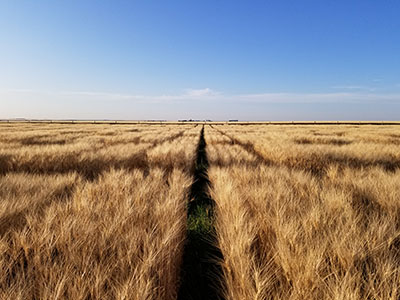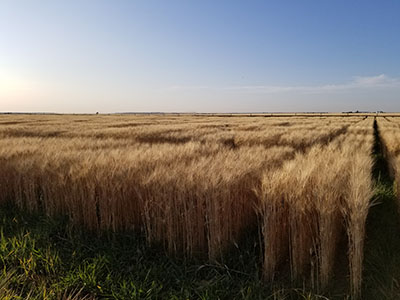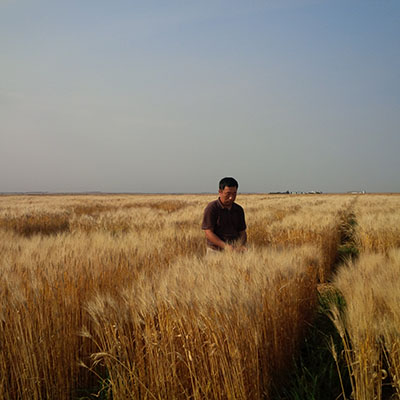For more information
Media Relations
Agriculture and Agri-Food Canada
1-866-345-7972
aafc.mediarelations-relationsmedias.aac@agr.gc.ca
Canada is a top producer of durum wheat on the international stage, but the spring wheat crop has faced production challenges owing to its moderate to high susceptibility to fungal diseases.
Since durum was introduced in Canada in the 1910s, it has been susceptible to the fungal disease Fusarium Head Blight (FHB).
To improve yield and strengthen FHB resistance, research scientist and durum wheat breeder Dr. Yuefeng Ruan and his breeding team at Agriculture and Agri-Food Canada’s (AAFC) Swift Current Research and Development Centre have developed a new registration-ready durum wheat line with an “Intermediate Resistance (IR)” rating to FHB. The variety is currently named DT2009. It is the first durum line in Canada and the world to demonstrate the IR level of resistance to this fungal disease.
Why do Fusarium Head Blight and other fungal diseases matter?
FHB is primarily found in wheat, barley, and oats. It creates mycotoxins that infect seeds and diminish the quality of harvested grains used in food and non-food applications. This is bad news for farmers and processors.
FHB epidemics have occurred several times in the Canadian Prairies in the last two decades. The prevalence of the fungal disease in durum wheat has even altered the course of production patterns throughout Canada, pushing production further west. The new wheat line’s intermediate resistance rating, however, signals a possible resumption of durum wheat production in the eastern Prairies, including Manitoba.
“DT2009 will give farmers an option to continually grow durum without the worry of Fusarium Head Blight, and will allow some FHB affected regions to grow durum wheat again,” says Dr. Yuefeng Ruan.
How was this new line developed, and when can farmers get their hands on it?
Developing resistance to the fungal disease in durum varieties involves cross-analyzing several genetic factors of the plant and their degree of resistance against the variations of the fungal pathogen, as well as its interactivity with changing environmental conditions.
Through a process called quantitative trait locus (QTL) mapping, breeders like Dr. Ruan can identify “markers” to define minor FHB resistance genes, and stack their resistance in durum breeding lines.
But it’s not only this one trait that the breeders need to worry about. They also have to think about other varietal characteristics that can mitigate yield-related threats. Just think of all the disease threats out there! The new line also scores highly here, demonstrating resistance to moderate resistance to all rusts including Ug99 stem rust, diseases that impact crops close to harvest.
Thanks to their breeding work, DT2009 is also high yielding, has high protein content, strong straw structure and good packages for other desirable traits of agronomy, disease, and quality.
“Thanks to a team effort at AAFC Swift Current, the new line is a breakthrough in the improvement of FHB resistance in durum wheat, which will increase its profitability for farmers. It’s the first and only durum line with the ‘Intermediate’ FHB resistance in Canada - and worldwide to date.”
- Dr. Yuefeng Ruan, Research Scientist, Agriculture and Agri-Food Canada
The process of taking a new variety from the researcher’s lab to the farmer’s field is a long one. It involves oversight and agreement by industry experts, who thoroughly evaluate the lines the research programs put forward. Currently, just one or two new durum lines from AAFC are approved for registration each year.
Supported for registration following the annual Prairie Grain Development Committee’s virtual registration event in 2021, the new breed of durum wheat will likely be available to farmers in about three years depending on the release date determined by seed companies. Dr. Ruan’s other accepted line, called DT2005, which also has excellent fungal resistance properties, would also be available for registration support.
Key Discoveries/Benefits:
- DT2009, a new registration-ready AAFC durum wheat line, demonstrates beneficial varietal characteristics including increased yield and an improved resistance to fungal disease Fusarium head blight (FHB) with an Intermediate Resistance (IR) rating – the first durum wheat line to be released in Canada.
- The breeding research program at AAFC’s Swift Current Research and Development Centre leverages genetic technologies to address agronomic and yield-related concerns associated with wheat and grain crop production, including fungal resistance and improved drought tolerance.
- With an IR response to FHB, the DT2009 line signals an opportunity for durum production to resume in FHB-affected regions, which could benefit overall yield in Canada and the quality of grains used in food and non-food applications.
Photo gallery


